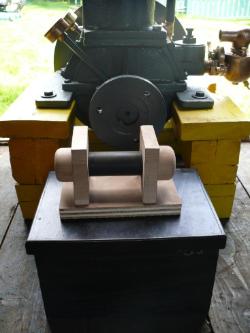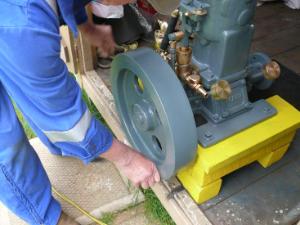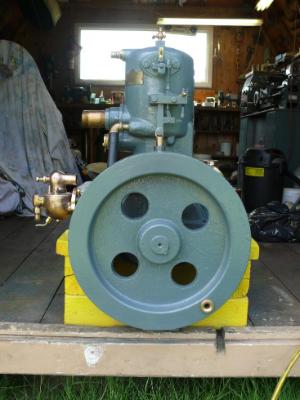Max Clarke - Make and Break Engines
Restoring the Past For the Future
Max Clarke's Make and Break Engines
Make and break marine engines have been around Newfoundland and Labrador since the early twentieth century. Introduced around 1910, the engines were a new form of transportation around the province. Transportation by boat had previously meant setting sails or rowing so the make and break engines were a welcome break from the labour of life in the harsh, unforgiving climate.
“For the most part in Newfoundland, they were using them up until the early 60s… up until then that’s all they used were the make and breaks. When the four cycle engines came on stream, particularly the diesel s, which didn’t burn very much fuel compared to the make and break, a lot of people got rid of them and just used them as an anchor… and forgot them” says Max Clarke of Paradise, who has refused to forget.
Max is an engineer who has become known for his knowledge of make and break engines. For the last few years he has been repairing and restoring these antique engines. He is now known among many in the make and break engine community for his skills with the old engines. I had the privileged to sit down with Max to talk about his knowledge and love of make and break engines.
“It’s a very simple engine,” says Max , “it probably got its name, make and break, because just about anything that could go wrong you could probably make it yourself or at least you could rig it so you wouldn’t be broken down.” He continues, “you could manage to get it to work somehow.”
“Most of its power is coming from the flywheel. The flywheel is so big and massive and huge once it starts turning you get kinetic energy” stated Max, talking about why the make and break engines were popular in Newfoundland and Labrador. The engines were simple and had very limited parts making it easy for fishermen to repair them quickly and cheaply while on land or water.

“Everybody was under the impression that this spring would break. But you could use an elastic band... Fishermen use to have elastic bands around their oil pants, it was just a rubber strap. This is what they would use to get home or you could just hold it with your finger until you got home. But everybody was under the impression that these springs break, but they didn’t break, they rusted out,” Max told me during our interview.
The salt water spray, that would have been an everyday part of life for the fishermen of Newfoundland and Labrador, was the leading factor in the degradation of these engines. “These engines, as fishermen used them, you would have spray coming over the boat all the time and it would go onto the engine. They didn’t even bother to protect them so [there was] salt water going over on a constant basis” stated Max.
The spray was also responsible for, what Max says, is the most serious problem with antique make and breaks –cracks in the cylinder head. “There’s a water jacket and what happens is you get a rust build up between the jacket and the cylinder liner and it just builds up and builds up,” explained Max, “When something builds up and has nowhere to go, something has to break.” At one point this might have meant that the life of the engine was over but, thanks to advances in technology, Max is able to repair most of these problems. He uses a machine lathe to make his own parts and modern epoxy filling to repair cracks to the outside of the cylinder.
While many men are now running diesel engines in their boats, Max saw owning a make and break engine powered boat as a privilege. “These engines were all but disappearing. I’ve always had a great affection, really, for the equipment and the craftsmanship which was put into these engines.” Max’s passion for these engines is obvious from his choice of words.
He is sometimes questioned about his old motor and boat. “People ask me why I have an old boat, a type of fishing boat, and an old engine. I would always answer them by saying ‘What about people with antique cars? Why do they have them? If people have antique cars, why can’t I have an antique boat and engine?’”
His love of make and break engines started when he was just a boy growing up in Southern Labrador. At that time, make and break engines were the only mode of transportation from isolated outport communities like the one Max grew up in.
During our interview he recalled his childhood when everyone had make and break
Max knows that he is not the only one on the island with a great appreciation and love for these engines. On the day that I talked to Max he told me a story about an elderly gentleman who felt the same connection to these engines. “There was this older gentleman and I was in to the yacht club and I heard a horn blow and it got my attention and I went over. Sam Bussey. I knew Sam, and he said ‘Where’s your boat?,’ this was the 4 Acadia, and I said ‘It’s down by the dock.’ ‘Oh,’ he said, ‘I thought it was gone.’ He said, ‘I went all around the bay looking for it.’ And he said, ‘You know, I raised my family with one of them.’ So the engines meant so much to them, it was part of their livelihood. If the engine didn’t work, they didn’t fish."
When asked to describe the feeling of being in a make and break powered boat a contemplative look fell over Max’s face. He responded, “I don’t know how you would describe something like that. It was part of your life.” He continued, “They were the only mode of transportation. We grew up in them.”
Since January 2012 Max has restored four antique make and break engines back to running order, one of which I had the privilege of seeing. It was his wife, Sandra, who provided me with the correct number of restorations this year after Max insisted he has only done five or six altogether. While he is modest about his abilities and knowledge, members of the make and break community continuously bring Max’s name up as the guy to talk to about make and breaks. With Max Clarke, the make and breaks will be around for years to come as he spreads his passion throughout the province in the form of a putt-putt engine.
Written by Joelle Carey
